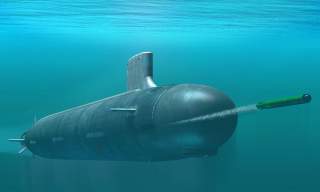The U.S. Military's 2017 Defense Budget Protects Its Most Important Weapon: Submarines
A big victory for the U.S. Navy.
The final version of the 2017 National Defense Authorization Act, which just passed the House of Representatives earlier today, protects the U.S. Navy’s submarine fleet and fully funds America’s new Ohio Replacement Program (ORP) ballistic missile submarines. The bill passed by a wide bipartisan margin after tough negotiations with the U.S. Senate.
“As we begin transitioning to a new administration, this measure makes a solid down payment on growing the fleet and meeting our security challenges on, below, and above the seas, by sustaining our path to a 308 ship fleet by 2021,” Congressman Joe Courtney (CT-02), ranking member of the Seapower and Projection Forces Subcommittee, told The National Interest in a statement. “I hope that the Senate will now quickly pass the conference report and send it to the President for his signature.”
Courtney said that he was especially pleased with the new defense bill. The new NDAA starts to address the severe shortfalls facing the U.S. Navy’s submarine fleet as it struggles to continue building two Virginia-class submarines while also building the ORP. “This report maintains two critical elements that I fought to retain from the House bill passed last May, but were not in the Senate bill: the expansion of the National Sea-based Deterrence Fund (NSBDF) to authorize continuous production of components on the Ohio-class Replacement Program, and the restoration of advanced procurement funding for future Virginia-class submarines that will keep the program on track,” Courtney said. “I have worked closely with Chairman [J. Randy] Forbes in advancing these initiatives, and I am proud that this agreement retains our hard work.”
For the Virginia-class submarine program, the NDAA authorizes two new boats for 2017 while adding advanced procurement money for sustaining a two per year build rate in 2018 and 2019. The total amount of funding goes $85 million over President Barack Obama’s budget request to ensure that the submarine industrial base can support the incorporation of the Virginia Payload Module in the forthcoming Block V Virginia-class submarines.
The new NDAA also fully funds the $1.9 billion the President requested for the ORP program. Indeed, Courtney led the effort to ensure that the ORP would not go unfunded due to a protracted continuing resolution. “The report fully authorizes the $1.9 billion budget request for the Ohio Replacement, and retains a provision included in the House version by Courtney and Forbes to expand the National Sea-Based Deterrence Fund to allow for the continuous production of components related to the missile compartment on the new submarines,” reads a statement from Courtney’s office. “Navy estimates have found that continuous production would save 25 percent of the cost of procuring missile tubes alone by buying them in a cost efficient and level loaded approach.”
Courtney and Forbes designed the NSBDF several years ago to ensure that the Navy can produce the new fleet while also meeting its other critical shipbuilding priorities.
Dave Majumdar is the defense editor for the National Interest. You can follow him on Twitter: @davemajumdar.

